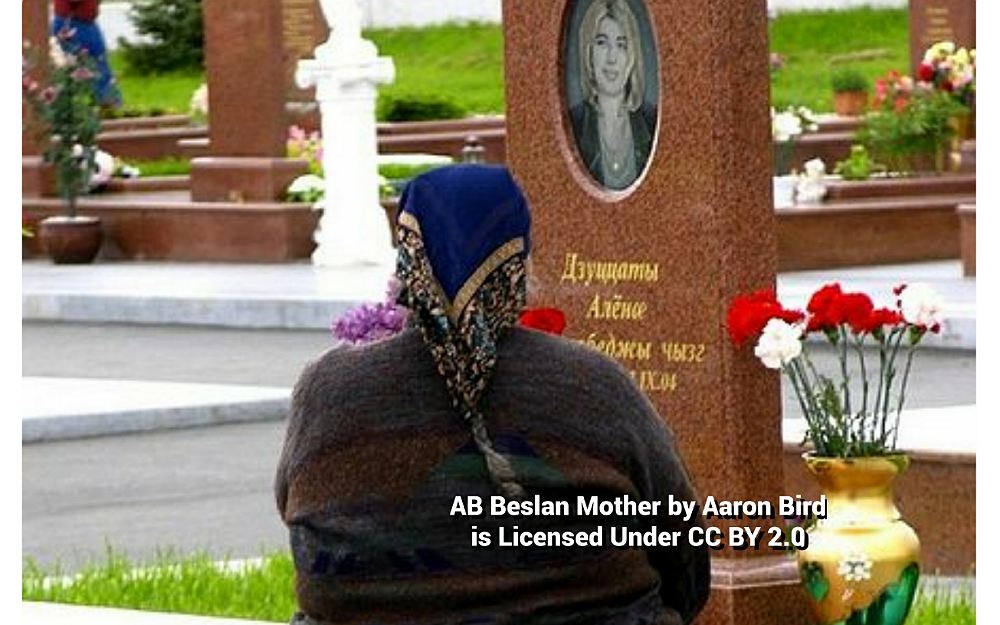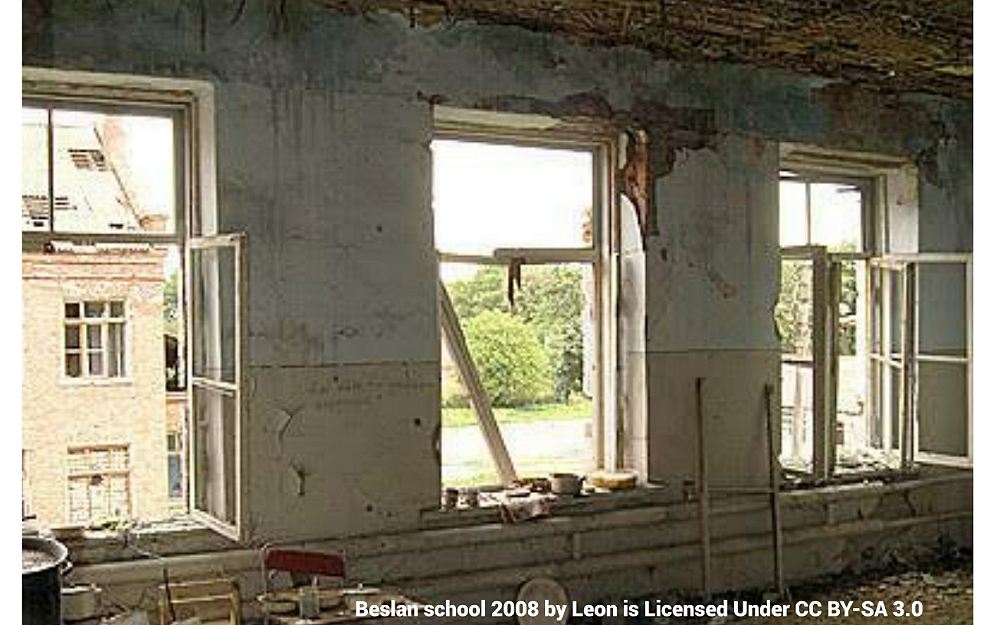Matthew Luxmoore
RFE/RL

On September 1, 2004, School No. 1 in Beslan, North Ossetia, welcomed children back after the summer break. There were nerves and excitement as a crowd of 1,128 parents, teachers, and pupils lined up in the courtyard at 9 a.m. for a ceremonial assembly ringing in the new school year.
Unbeknownst to those gathered, some 30 Chechen and Ingush separatists had crossed into North Ossetia hours before, armed with guns and ammunition seized during an earlier raid on a weapons depot in Nazran.
They struck during the festivities. Herding over 1,000 people into the school gymnasium, they issued demands that Russia withdraw its troops from Chechnya. It was the beginning of a standoff with security forces that lasted 52 hours, time the hostages — among them some 800 children — spent virtually deprived of food and water. By the following morning, the terrorists had executed several men and transformed the school into a mined stronghold.
Around 1 p.m. on September 3, two explosions emanated from inside the gymnasium. As hostages began escaping through the windows, pursued by small-arms fire from their captors, Russian special forces launched a bungled rescue operation that spilled into surrounding streets and ended only 10 hours later with the deaths of 334 people — including 186 children — and hundreds of wounded.
In Beslan, a town of 37,000 people, few families were left untouched.
Funerals were held under pouring rain in the days that followed. The body count was so high that a new cemetery was built outside town. Today it’s visible along the road from the airport to the regional capital Vladikavkaz, with its name displayed prominently above the entrance: City of Angels.
Heavy-Handed Methods
Fifteen years after the attack that shook the entire world and transformed Russia, its survivors and the families of those who died are still demanding an objective investigation into how the attack was carried out and why security forces resorted to such heavy-handed methods to end it.
The operation to clear the school killed all the militants except one. In 2006, unemployed Chechen carpenter Nurpashi Kulayev was sentenced to life in prison for his involvement.
Victims were compensated, some reforms introduced, and various government commissions released conflicting assessments about the role the state played in bringing about the catastrophic death toll.
But to this day, few are satisfied with the answers that have been provided.
“There have been no efforts on the part of authorities toward a worthy investigation,” said Agunda Vatayeva, who as a 13-year-old survived the attack by escaping from the school’s cafeteria while her mother, too weak to move, died inside from fatal shrapnel wounds.
Following the tragedy, Vatayeva was sent to Moscow to be treated for severe injuries she suffered when a grenade or a mine exploded in her vicinity. The Russian state compensated Vatayeva for her injuries and subsidized her care. Her family also received a 1-million-ruble payout (about $37,000) for her mother’s death.
Vatayeva, who now lives in Vladikavkaz with her husband and children, still has fragments of shrapnel lodged in her head. She is convinced that at least some of the injuries she suffered during the siege — and those that claimed her mother’s life — were caused by the use of excessive force by Russian special forces, including the alleged deployment of tanks and flamethrowers. For her, material compensation does nothing to help victims achieve closure.
“I think that under the current government, while people who were in power at the time are still alive, including our president, we won’t learn anything new,” she said in an interview, noting the lack of change in the government’s narrative over time. “Because that means they’d have to admit their guilt.”

In 2007, in a push for justice and an effort to ascertain what really happened in Beslan, Vatayeva and some 400 others — survivors of the terrorist attack and relatives of those killed or wounded — appealed to the European Court of Human Rights (ECHR), seeking to compel the Russian government to account for its chaotic response during the tragedy.
The court’s ruling was a long time coming. But in April 2017 it issued a scathing assessment of the authorities’ handling of the crisis. It noted their “failure to take preventive measures” against a planned terrorist attack in the area despite being “in possession of sufficiently specific information” about it. Security at the school was not boosted, the report concluded, and the public never warned about the possible danger.
In light of claims from some quarters that Russian security forces had initiated the firefight that provoked the militants into a panicky massacre of hostages, the ECHR noted “serious shortcomings in the planning and control of the security operation,” with law enforcement agencies stepping on one another’s toes and apparently no command structure present.
“In the absence of proper legal rules, powerful weapons such as tank cannon, grenade launchers, and flamethrowers had been used on the school. This had contributed to the casualties among the hostages,” the report asserted.
The ECHR instructed the Russian government to issue over 3 million euros ($3.3 million) in further compensation to victims. The Justice Ministry appealed the ruling, but that September it announced its decision to comply. Vatayeva received 7,000 euros ($7,700), which helped her cover medical bills.
But Beslan remains split over whom to blame for the catastrophic loss of life, with much skepticism about outside probes. Nadia Guriyeva, a teacher who lost two of her children in the attack but managed to escape with her third, told RFE/RL in a phone interview that she was opposed to the ECHR’s involvement.
“I did not endorse that application,” she said, adding that she trusts the Russian government’s ongoing investigation. “I think competent people are doing their jobs. But, of course, I’d like it to be quicker. Everyone would.”
Fifteen years on, she believes Russian servicemen did all they could in the circumstances.
“Practically every person has their own version of what happened,” she said. “It’s always like that. But how can you blame people whose actions enabled hundreds of people to get out of there alive?”
A Powder Keg
Russia has fought two wars against separatist rebels in Chechnya, and violence has often spilled over into other regions. The attack in Beslan was the fourth terrorist act involving hostages in the previous 10 years. It came only two years after Chechen terrorists stormed Moscow’s Dubrovka Theater, a standoff that only ended when Russian special forces mounted a failed operation to free the hostages, leading to at least 130 deaths.
Irina Borogan, co-author of The New Nobility, a book about the Russian secret services, covered both the Dubrovka and Beslan sieges as a journalist. She said the rescue operation in Beslan “was total chaos,” even by comparison with what she had witnessed two years previously in Moscow.
“It was obvious the authorities had no plan,” she told RFE/RL. “They were simply not ready for such an event in the North Caucasus, after the war in Chechnya had been declared finished.”
Like others, Borogan warns that Russia’s position in the North Caucasus remains fraught. Its various republics — foremost Chechnya, Ingushetia, and Daghestan — have unresolved conflicts over culture and territory that in their current form date back to the Soviet collapse. And some fear that while relatively dormant for now, they may escalate into conflicts down the line.
“This has not gone anywhere,” Olga Allyonova, author of a forthcoming book about Beslan, told the TV station RTVI.“It’s a powder keg, and it’s scary to think it can explode at any moment.”
She expressed skepticism that the truth about Beslan will ever emerge.
“To this day, there are several versions about who shot from where, how many groups were involved, under whose command, and the number of hostages taken,” she said. “Fifteen years on, there are no answers to simple questions. Of course, I don’t believe these answers will appear.”
She expressed skepticism that the truth about Beslan will ever emerge.
“To this day, there are several versions about who shot from where, how many groups were involved, under whose command, and the number of hostages taken,” she said. “Fifteen years on, there are no answers to simple questions. Of course, I don’t believe these answers will appear.”
‘We Still Don’t Know’
Beslan native Dana Tsinoyeva lived right next to School No. 1. Her father and three sisters had all studied there, as she had. Before the tragedy, she said, the school had been a centerpiece of the local community, a place where a welcoming atmosphere prevailed.
“It was a wonderful, brightly lit school,” she said in an interview. “Anyone could just walk in — the doors were always open. You entered as if into your own home.”
Tsinoyeva was 19 when the siege took place. She had only recently graduated from the school to begin undergraduate studies in Vladikavkaz.
Her 13-year-old cousin, Inga Tsinoyeva, was not so lucky. On September 4, she was found among the charred remains in the gymnasium, having never got the chance to begin seventh grade.
“I remember she had just got her navel pierced without her mother’s permission,” Tsinoyeva said. “But Inga’s mother knew she was stubborn enough to do it anyway.”
“And it was by that piercing that they identified her body,” Tsinoyeva added.
The gymnasium where the victims were held hostage, pockmarked by bullets and shrapnel, would have been razed if not for the insistence of survivors and relatives that it remain standing for posterity.
Today, the ruins are covered by a golden sarcophagus that shields them from the elements. Visitors are free to enter and soak in the eerie atmosphere. Along the walls, photographs of the fresh-faced children and school employees who died there are on display. Beneath them lie children’s toys, religious icons, and bouquets of flowers brought each year for the anniversary ceremonies.
Along sections of the gymnasium’s outer wall, where gaping holes remain from the blasted-out windows, stand dozens of half-full plastic bottles, which are still brought by visitors to honor the children who died gasping for a drop of water.
“During those three days, we all gathered in the main square and awaited information,” Tsinoyeva recalled. “There was a sense that we’re one family, that we’ll get through this, and that we’ll punish those responsible.”
But soon, she said, “people retreated into themselves: some turned to religion, others barricaded themselves at home. There was utter gloom and hopelessness.”
One of Tsinoyeva’s neighbors in her five-story apartment block was among the several Beslan residents who took their own lives in the aftermath. He had lost a son in the siege.
She said the lack of clarity over what happened 15 years ago remains for many the most painful element to accept.
“There were various conclusions, and it’s still unclear whom to blame,” she said. “The investigations never gave us a clear answer. Who ordered it? Who were these people? We still don’t know.”
Copyright (c) 2019. RFE/RL, Inc. Reprinted with the permission of Radio Free Europe/Radio Liberty, 1201 Connecticut Ave NW, Ste 400, Washington DC 20036
You know Independent Journalism needs fund to run the not for profit venture Please contribute if you like our effort Donate through PayPal Or paytm +919903783187 phone pe +919875416249 Google Pay +919875416249 Amazon Pay +919875416249 BHIM +919875416249 or write to us editor@crimeandmoreworld.com
You can get story updates or contact us on Whats App Messenger +919073399779










